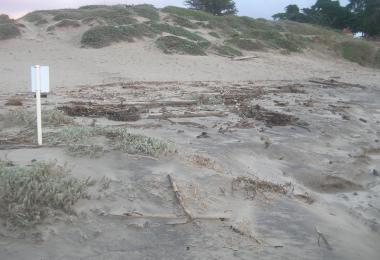Western snowy plovers (Charadrius nivosus nivosus) reside year round on the beaches of Southern California. These rare, little birds (about the size of a sparrow) prefer wide beaches where they nest in the dunes and feed on invertebrates in the surf line and wrack. They often return to the same breeding sites and stay close to where they were born, making them extremely vulnerable to habitat loss. As a result, in 1993 western snowy plovers were listed as a threatened species.


Unfortunately, the only remaining habitat for snowy plovers is adjacent to recreational areas. Snowy plovers are especially vulnerable to human activities. People, dogs, and even horses on the beach can cause them physical harm and block them from their food. If plovers are disrupted during feeding or forced to leave their nests, adult plovers will either run very quickly or will take flight into the safety of the dunes, leaving their eggs and chicks vulnerable to trampling, predation, and adverse effects from the resulting drop in temperature.


Saving Plovers
An example of habitat restoration and public education to support snowy plovers is the docent program at Coal Oil Point Reserve near Santa Barbara. Following the protection standards for snowy plover recovery, set at Point Reyes in 1995, the program relies on public education to protect the species. The reserve – 170 acres of coastal and estuarine habitat – is a refuge for hundreds of avian species. In 2001, volunteers were recruited to monitor the beach and educate the public about the birds. Prior to the program, there were only 2–4 nests between 1970 and 2000 at Sands Beach. This number swelled to 57 nests in 2008, with 38% of the nests hatching, resulting in 39 fledged chicks. Through volunteers informing beachgoers on the sandy beach, this program has changed the area from being devoid of plovers to being a site with active breeding.
The program has had a vital role in informing and regulating beachgoers’ use of the beach, ensuring they follow regulations such as staying away from fenced-off areas and keeping their dogs leashed. The program can now be considered a model for other areas along the California coast.
The snowy plover has become a symbol of the importance of coastal habitat protection in Southern California but this charismatic creature is just one of many shorebirds that depend on our beaches.


